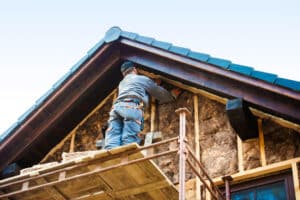The most critical component of a home is its roof. The roofing structure needs to be durable and the roofing materials need to be able to withstand wear and tear. If damage has occurred to your roof, it either needs to be repaired or replaced. Roof replacement can be a tricky task and is not for the faint of heart. Roof replacement can also take a significant amount of time, so finding the best time of year will help your project go off without issue. Here are some tips to help you schedule your roof replacement and how to choose the best timeline for your schedule.

Consider The Age Of Your Roof First
Not all homes need roof replacement to look their best. Some older roofs need to be replaced because of bacteria growth or deterioration. If your home is older than 20-25 years, you may want to schedule replacement sooner rather than later. If your roof isn’t past this window, you may be able to push off the service to a warmer season or when roofers are less busy.
Although you should take the age of your roofing material into consideration, age is not the only determining factor to indicate when your roof needs to be replaced. In certain climates, roofing materials may deteriorate faster. If you have not maintained your roof over the years, roof replacement may be needed sooner because of wood rotting or moisture seeping into the structure.
Avoiding Peak Seasons
The spring or fall weather are optimal times to work on a roof, however, these can be busy seasons for roofing companies. If you want to hire a roofing professional to replace your roof, considering when their schedule might be less full will help your project get completed faster. For homeowners who can push off the replacement without compromising their safety, you can benefit by potentially having the roofers work around your schedule and save money due to lower demand.
Challenges Of Roof Replacement In Winter
Each season of the year will come with its own set of challenges when working on a roof. Working on a roof during the winter in Idaho can come with longer timelines and malfunctions in materials. During the winter, roofers may encounter heavy snow, rain, and high winds. All of these can mix together to create unsafe working conditions. Working in the snow or rain can lead to injury or falls.

Winter can also cause shingles to become cold and brittle during installation. When shingles are cold, they become harder to bend and cut to the perfect shape for your roof. Applying shingles to ridge caps, hips, or roof valleys will be more difficult because you need to manipulate the shingles quite a lot in these areas.
The adhesive of shingles also can be weakened by the lower temperatures. Once temperatures drop between 40 degrees Fahrenheit, the adhesive properties start to change. This makes it hard for them to stick to the roofing structure and other shingles.
To work around this issue, you may have to choose another roofing material if you want the roof replacement to happen during the winter.
Challenges Of Roof Replacement In Summer
Having roof replacements in the summer can also pose challenges for a roofing company. Summer temperatures can also be difficult to work in since your roof can be around 20 degrees hotter than the ground. This makes it dangerous to work on your roof on extremely hot days when the sun is beating down. Your roofers will need to stay hydrated and take more breaks to avoid heat exhaustion.
Just like the cold weather can alter roofing materials, the sun can also change the shingles or roofing tiles. The sun can cause them to deteriorate quickly, especially if you are using asphalt shingles. To avoid this, many roofing companies work in the early hours of the morning during the summer or in the late afternoon when the sun is not as high in the sky. This can be a challenge to your schedule or disrupt your daily routine when the roofers are not working during typical working hours.
The summertime can also make your roof more susceptible to leaks because materials expand and contract. If your roof was leaking before scheduling a roof replacement, this could cause your leaks to expand and become more of a major problem. If the leaks are small and can be coped with, roof replacement can take place during the summer.

Some roofing contractors may have the tools to help keep leaks at bay during roof replacement. Other problems can always arise during a home project, so roofing contractors should be able to adapt. However, any challenges you experience during different seasons can push the completion of your project back a few weeks or months.


